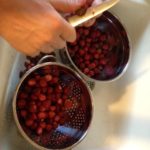 This is our seventh year with a farm share. Each year the two of us order a large family size share and put away a significant amount of food for the winter and eat like kings. Each year we waste less food and receive more nutritional value from our share, but it is definitely a learning process. This blog post is meant to speed up that learning curve. It isn’t a complete list and it is just part one, but hope it helps.
This is our seventh year with a farm share. Each year the two of us order a large family size share and put away a significant amount of food for the winter and eat like kings. Each year we waste less food and receive more nutritional value from our share, but it is definitely a learning process. This blog post is meant to speed up that learning curve. It isn’t a complete list and it is just part one, but hope it helps.
What is a farm share?
Community Supported Agriculture or a CSA is a purchased share of a small local farm. A community member pays for a weekly share of fruits and veggies upfront (sometime between October and May) to help the farm raise funds for the growing season. To find a farm share in your area click on this national registry.
Tricks
- The internet is everything. If you get a strange type of food you have never seen before, take it home and Google it. Before long you will have 40 recipes on how to cook it or grill it or store it away for the winter.
- Try everything a few times and cook it a different way each time. Then you can decide if you really can’t digest it or just really don’t like it.
- Choose a farm that offers a “you-pick” option and show up every week with enough time to actually pick all that you are allowed to take. It is good physical labor and deeply connects you to the earth. Picking beans or strawberries, might just end up being the highlight of your week.
- Use this as an opportunity to tell the visual difference between foods and then the difference in taste. If you don’t know how to recognize different herbs by sight, start picking them and learning how to cook with them.
- Set aside an evening to process the farm share and make sure it is the evening of the pick up. Some weeks it might take 30 minutes, other weeks it might take 2-3 hours of work to really make the most of your farm share.
What do you need at home in order to have a farm share?
- Salad spinner
- Gallon size storage bags
- Paper towels
- Clean fridge and clean kitchen
- Two to three large wide mouthed vases
- Three to four strainers
- Lots of small and large bowls
- Big dinner plates
- Cookie sheets
- Food mill
- Internet connection and (Smitten Kitchen, Nourished Kitchen, Vegetarian Cooking For Everyone, this amazing food preservation website)
- COMPOST!!!!!
- And maybe a blender (Vitamix or Nutribullet that keeps fibers in the juice)
 The Star Line Up and How To Put Them Away
The Star Line Up and How To Put Them Away
Salad Greens (varieties include: red and green leaf, romaine, boston lettuce, etc)
Options: juicing or eating as salads
Prep: wash immediately, put in salad spinner to dry as much as possible, store in gallon size plastic bags with one to two paper towels inside for absorbing water. This will stretch life span to 10 days or so.
Unusual Cooking Greens (tot soi, arugula, mustard greens, dandelion greens, etc)
Options: juicing, eating in salads or cooking
Prep: same as Salad Greens
Suggestions: bitter loves mustard, fats, and salt
Important Greens (kale, chard, collards, spinach, bok choy)
Options: juicing or cooking, freezing
Prep: same as salad greens, but remove bulky stems and just pack up leaves
Suggestions: Cook collards for the longest, kale next longest, spinach and chard cook before your eyes. Spinach and chard need fat added for best nutritional absorption (think butter or olive oil). Separate stems of bok choy and leaves, sauté stems for a long time and then just throw in leaves at end.
Options: eating, baking, jamming, freezing
Prep: wash and stem strawberries immediately and put in a sealed container in the fridge to eat slowly throughout the weak or make jam immediately
Suggestions: Jamming is the best way to handle insane amounts of strawberries but uses a lot of sugar and takes significant time, freezing is almost always a disappointment, we prefer to bake strawberries into muffins or breads and freeze them. Muffins and breads freeze very well and are easy to thaw or toss straight into a hot oven to warm up. If you have an ice cream maker, homemade strawberry sorbet is the perfect way to secure the brilliance of summer strawberries and freezes well all winter.
Prep: nothing, put in vase with warm water and leave on counter top, change water every three days, cut off any falling off ends
Suggestions: use in place of onions, use all or most of the green part, with leeks slice up the rounds and then soak them in water if they are very dirty and then rinse again.
Turnips/Radishes
Options: eat raw on salad or slice and add to a stirfry
Prep: cut off greens and put in storage bag inside of fridge, in a bag they will last forever, out of a bag they will make a mess of your fridge in a week
Cucumbers
Options: Cook with them, eat them, pickle, ferment
Prep: throw in fridge
Suggestions: cold cucumber soup, tzatziki, replacement for cheese in pesto
Zucchini
Options: Everything
Prep: throw in fridge
Suggestions: bread, muffins, pizza crust filling, brownies, pasta replacement, soup (very freezable and even though you think zucchini soup sounds terrible in August, it will be delicious in February)
Yellow Summer Squash
Options: Stir-fry, sauté, steam, grilled, raw in salads
Prep: throw in fridge
Suggestions: Good with garlic and green onions,
Carrots
Options: Steam, sauté, bake, pickle, juice
Prep: Store in fridge in a plastic bag or in a root cellar in a plastic bag
Suggestions: carrot bread, muffins and cakes are a tasty way to get rid of tons of carrots all at once.
Fresh onions, Fresh Garlic
Options: Cook normally, though be prepared for more intensity
Prep: they have not been dried and therefore need to be refrigerated until use
Suggestions: Basil or mint pesto with the fresh garlic
Broccoli
Options: cook, freeze
Prep: throw in fridge and use asap
Suggestions: pizza topping, lightly boiled and covered in lemon juice and parmesan cheese, freezing broccoli is awesome
Broccoli Rabe
Options: this
Eggplant (all varieties)
Options: must cook
Prep: throw in fridge, use quickly
Suggestions: with capers and mint, soup, baba ganoush
Peppers
Options: freeze
Prep: leave on the counter, separate from fruit
Suggestions: wash, cut into big chunks and place on cookie sheet, freeze, remove from freezer and pour pieces of pepper into plastic storage bag and return to freezer, excellent for soups, sauces and cooking all winter long
Hot Peppers
Options: use what you want, freeze, dry
Prep: wash, dry, place in plastic bag whole and put in fridge, keep adding to your hot pepper bag as you accumulate or leave on a flat surface and dry completely (might take weeks)
Beets
Options: juice, cook, roast, boil with vinegar
Prep: put in storage bag and put in fridge
Suggestions: we roast beets ahead of time to have roasted beet salad with goat cheese and walnuts, also very good with winter squash in roasted root vegetable medleys and soups
Tomatoes
Options: Sauce, can, freeze, salsa, eat sliced
Prep: leave on counter until ready to eat
Suggestions: with eggs, put thickly sliced tomatoes into stock pot and simmer for hours until thick enough for pizza sauce, run through food mill and then freeze in storage bags,
Cooking Herbs
Options: use, juice, dry
Prep: wash, run through salad spinner, separate herbs and lay out on a plate and leave for several weeks to dry, or hang in bunches around the house, when crumbly, break them into little pieces and put in container to use dried herbs over the winter
Suggestions: long stemmed parsley used for juicing keeps well in water in the fridge and will last for a week or two, basil is also very good for juicing

